Ferry House, 51-57 Lacy Road, Putney, SW15
228 Munster Road, London, SW6
Domark were Mark Strachan and Dominic Wheatley (grandson of author Dennis Wheatley). The pair combined their first names to christen their company, like those couples who conjoin their names when they buy a house and end up living in a home called Kenmar.
 |
| April 2023 |
Domark's first office was at 228 Munster Road, a busy street in deepest Fulham. It's the Fulham Kitchen in the photo above and presumably the company was established in the rooms above the ground floor. The company was named on 11th May 1984 according to records at Companies House. There's a YOUR SINCLAIR interview with the pair (October 1988 page 121) in which they talk to Graeme Kidd about the early days of the company:
"It was Dominic’s idea. In 1983 we spotted that software was poorly marketed, and we were crazy enough - rightly as it turned out - to leave our jobs and set up our own software business.” Dominic bought Heroes Of Karn on the C64 for his son, and showed it to Mark. “It was like magic... I was amazed that you could interact with a computer in that way... yes, it was like Paul Daniels -1 was stunned."
Heroes of Karn, by Interceptor Software, was an illustrated text adventure which explains perhaps why Domark's first game Eureka! was done in the same style, although with the addition of a very small arcade component. The game was a big five part adventure. The first four parts could be loaded and completed in any order while access to the fifth required information from the previous sections before it could be tackled. Ian Livingstone, then of Games Workshop, wrote the storyline and the game was contracted to Andromeda Software who handed it on to Novatrade, programmers in Hungary.
"The computer game is DEAD... LONG LIVE Eureka!" It's a bold claim expressed in a series of quarter page adverts which began running in October 1984; including apparently one in the SUNDAY TIMES which I haven't been able to track down. Right from the beginning the founders made it clear where their expertise lay. Mark Strachan told MICRO ADVENTURER: "Dominic and I know absolutely nothing about computer games but we know a great deal about marketing." (December 1984 page 6).
The game itself received positive but lukewarm reviews. What caught everyone's attention was the £25,000 prize for the first person to complete it. Eureka! wasn't the first computer game to offer a big prize for completion, that would probably be Pimania, from Automata, launched in 1982, with a chance to win the Golden Sundial of Pi (valued at £6000). The prize was finally claimed on 22nd July 1985. Eureka! sold 15,000 copies, "decent sales" according to Dominic Wheatley in a 2011 interview for MONEY WEEK, at a higher than usual price of £14.95. Two years later, as part of the joint CRASH/Domark competition to design a game, Mark Strachan gave an outline of how much a company like Domark earned from each sale and how income was spent:
"Say we decide to charge £7.95 for [competition winning game] Kat Trap. Over half the retail price goes to shops so that leaves about £3.00 for Domark. Out of that £3.00 we've got to pay for the box, the tape, labels, duplication and assembly costs -someone has to put the package together. Actually making the physical product which is sold in the shops could cost £1. That leaves us with £2.
Out of that £2 we have to pay for advertising and promotion, which could easily eat up half of the money remaining, and then there are the royalties which have to be paid to the programmer."
Eureka! cost £50,000 to program and the MONEY WEEK interview describes Eureka!'s development costs as "cheap". This is ironic considering comments by Donát Kiss of Novatrade in a Youtube documentary called Moleman 4 about games development in Hungary. Donát Kiss describes being given the "practically impossible" specifications for Eureka! and telling "Robi" (Robert Stein of Andromeda Software) to "tell them a large number,” which he did, giving Domark "a number with more zeroes in it than we’d ever seen before, thinking that they’d turn us down immediately. The next day the phone rang and we had been greenlit. We were ready to go." In the YOUR SINCLAIR interview with Graeme Kidd a rueful Dominic Wheatley crunched the numbers:
"I went to Hungary to see how things were going,” Dominic remembers, “and I ended up going to dinner with some of the programmers - four or five were working on the project and it took them about five months to complete. I asked them what sort of money programmers were paid, and they told me about £50 a month was par for the course. Even with a generous allowance for expenses, wages and overheads, it can’t have cost Andromeda more than £5,000 to program our game - and we’d paid £50,000 up front..."
Eureka was launched on 31st October 1984 and the prize contest ran until 31st December 1985. The prize was claimed around September 1985 when "15 year- old Middlesex schoolboy, Matthew Woodley" rang the all important phone number (PERSONAL COMPUTER NEWS 5-11 September 1985 page 5). CRASH printed a picture of Matthew being presented with an oversized novelty check in the October 1985 issue. Matt kept in touch with Dominic and Mark, and would go on to work for Domark as marketing manager from 1992 to 1995.
The £25,000 prize for completing Eureka! got the game noticed by press beyond computer games magazines. The pressure was on for Domark's second game to be equally attention grabbing but first there was a move to be completed.
204 Worple Road, London, SW20
 |
| April 2023 |
Domark went south of the river to an address between Wimbledon and Raynes Park. Whatever was on the site originally is long gone, replaced by a block of flats numbered 204-206 which, to my inexpert eye, looks like it was built in the 1990s.
Their second game was the officially licenced version of A View to a Kill, diligently referred to in all adverts as A View To A Kill The Computer Game in case anyone was confused by what they were buying; Activision's Ghostbusters carried the same The Computer Game tag on adverts (and so did some early adverts for Datasoft's The Goonies so maybe it was seen as a standard boilerplate description at the time.
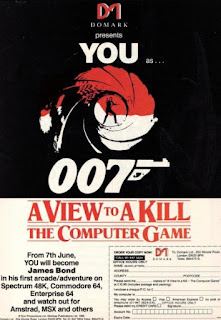 |
| POPULAR COMPUTING WEEKLY 6-12 June 1985 page 34 |
A View To A Kill The Computer Game was one of the earliest film licences in the UK; unless I'm mistaken before A View To A Kill there was only Alien from Argus Press Software, The Evil Dead from Palace Software, and Ghostbusters. Eureka! was only available for the Commodore 64 and Spectrum, but A View To A Kill was released on the Spectrum, C64, Amstrad, MSX, and, unusually by 1985, the Oric 1/Oric Atmos. There was also a version planned for the Elan Enterprise, which several companies were supporting at the time notably Realtime Games with Starstrike, but the Enterprise version doesn't seem to have been released.
Domark must have thought they couldn't miss. Ghostbusters was selling like crazy and topped the charts for the first three months of 1985, and ended up the fourth best selling game of 1985; after The Way of the Exploding Fist, Soft Aid, and Elite. (POPULAR COMPUTING WEEKLY 20-26 March 1986 page 4). Wikipedia has a quote from Dominic Wheatley that the game was "actually quite successful" which I think translates from marketing-speak as "didn't sell anywhere near as many copies as Ghostbusters." At £9.95 Ghostbusters was already pricy but sold well because people were excited by the film. My brother and I were prepared to cough up for Ghostbusters sight unseen, although this would turn out to be the last time we brought a game without first reading reviews. A View To A Kill The Computer Game was even more expensive at £10.99. It was released on 7th June, to tie in with the film, and maybe this hurt sales -which tend to be higher around Christmas- or maybe it was the muted response to the film. Still, at least Domark had fun taking PR photos.
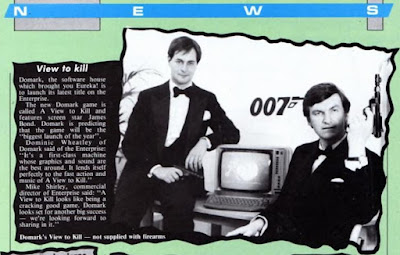 |
| HOME COMPUTING WEEKLY 14 May 1985 page 5 |
 |
| HOME COMPUTING WEEKLY 18 June 1985 page 8 |
Domark moved to licence another film. A more controversial one. Friday 13th The Computer Game, yes Domark was still using that tag. The decision to licence a game from the slasher film seems odd until you go back and look at that list of UK film based games; Alien rated X in the cinema; The Evil Dead, rated X; Ghostbusters rated PG, but with a supernatural theme. By 1985 the only additions to the list were Gremlins, rated 15, and Give My Regards to Broad Street, PG, although a game based on Rambo First Blood Part II, rated 15, had been announced in the summer of 1985. What does that list tell you? If you're going to make a game from a film licence it should have a horror/supernatural theme and -even if games tend to be aimed at younger teenagers- it should be based on an adult rated title. Seen through this prism a game based on Friday 13th, rated X in the cinema, suddenly makes sense. Oh, and by releasing a game based on Give My Regards to Broad Street, Argus Press Software were apparently massively out of step with what other companies were doing.
In retrospect Friday 13th The Computer Game seems doomed from the start. The tone was inconsistent. The game was designed as a horror spoof, as your character panicked their hair stood on end and the box included two blood capsules, but the package and advertising recycled the poster from the fourth film in the series, 1984's Friday the 13th: The Final Chapter and was regarded as too graphic. "The idea was originally presented by the film company as something rather eye- catching," Dominic Wheatley told SINCLAIR USER in January 1986. John Menzies refused to carry the game and the adverts generated complaints. The cover was changed by removing the artwork and simply leaving a blank space. Very few pictures of this blank cover exist, the only one I've been able to track down is a picture of the Amstrad box at cpcrulez.fr
CRASH probably came off worst from the whole business. They printed a preview of the game in their December 1985 issue and the article and editorial pictures all attracted heavy criticism, but the heaviest criticism was reserved for the cover. "Disgusted," "horrific", "disturbing," "sick", "horrific" (again), "mindless gore," "gruesome", "frightening", "computerised sex orgies for under fifteens." The last one was off-target but readers, and more significantly parents of readers, were unimpressed. At least one reader complained to the Press Council. Looking back, in issue 46, Lloyd Mangram wrote:
"though this isn't the worst CRASH cover it's certainly Oliver [Frey]'s poorest. There's no doubting the visual impact... but there's also little doubt that this was a subject in which Oliver had little interest - or rather, he felt less out of sorts with the subject than with the way the Editor [Graeme Kidd] wanted it portrayed."
"Some readers, newsagents and several reader's parents were appalled by the cover, and extended their opprobrium to the Friday The 13th preview which showed Domark's Mark Strachan and Dominic Wheatley posed in a particularly gruesome and bloody manner...I defended the cover in the Forum but it was seen as unfortunate in the sense that the preview was a thin editorial excuse for forcing the cover idea on Oliver - especially thin when you consider that the game itself would not be reviewed till June 1986 and then would only receive 32%!
Roger Kean had expressed doubts about the subject, feeling that it would be better to do a humorous picture, more in the cartoon style of Mad, but he was away from Ludlow when the final decision was taken and the cover painted."
Domark's third game snuck out around Christmas 1985, before Friday 13th The Computer Game hit the shops. There's some small irony in the fact that Gladiator was considerably more violent than Friday 13th, requiring the player to control a slave killing his way to freedom, and the Gladiator advert is considerably more gruesome, showing actual acts of violence, but it's easily overlooked because of its bright comic book style.
Gladiator attracted middling to positive reviews but it went largely overlooked, lost among a wave of similar beat-em-ups released in the wake of Way of the Exploding Fist. The most notable thing for me was always CRASH's spoof of the Gladiator advert, used on a competition.
A rethink was clearly required. Signs of an improvement came with Split Personalities. A game quickly renamed after Domark was contacted by lawyers acting for Central Television who felt the original name, Splitting Images, and advertising breached their rights. Interestingly, the Spanish version of Split Personalities, released by Zafi Chip, reused the original artwork. Presumably Central Television's lawyers did not reach as far as Madrid.
Dominic Wheatley gave an inadvertently hilarious comment to POPULAR COMPUTING WEEKLY: "It's all rather a laugh really. The Spitting Image people have a TV show which I've never seen, and they're a great big company which could sit on us like that." The news story continues:
"The overwhelming reaction of the distributors is 'what creeps'", said Wheatley, referring to Spitting Image Productions rather than Domark. "They parody everyone else, but as soon as you parody them you're in trouble.
He added that he hasn't seen the show, any parody was accidental.
He also denied that stunts of this sort were cheaper than advertising."
I like to imagine Domark's lawyer sitting to one side making frantic stop-talking gestures and passing notes reminding Wheatley to stress he hadn't seen the show.
The turnaround in quality continued with the official computer game version of Trivial Pursuit. "With Trivial Pursuit we went to the programmers once a week with a crate of Fosters, and programming stopped for an hour. We followed the development of the game in great detail, and had control throughout." Dominic Wheatley told Graeme Kidd in YOUR SINCLAIR. It worked, the game was massively successful. As Wikipedia summarises: " Released in 1986, the Trivial Pursuit sold roughly 2 million copies. The success allowed Domark to move into proper offices and hire more employees."
I'm intrigued by the "proper offices" comment. Worple Road is largely residential, big semi-detached houses that look late Victorian or Edwardian, and I wonder if 204 Worple Road could have been someone's house? The CRASH preview for Friday 13th includes another in the Domark daft-PR-photo series which is captioned "Mark and Dominic loon around in the Domark boardroom," but look at the background to the photo. It doesn't look very business-like. It looks like someone's front room. The only clues come from the layersoflondon.org website where the 1940-1960 Ordinance Survey map shows 204 Worple Road has a garden out the back; so maybe it was a house or flats?
Domark flirted with a spin-off label called Streetwise. Two games were released on this label in 1986; Orbix the Terrorball and Kat Trap Planet of the Catmen; winner of the 1986 CRASH competition to design a game, and programmed by Design Design. CRASH ran a second Design a Game contest in April 1987, once again the winning title would be programmed by Design Design, and Domark would release the game on the Streetwise label. The winning entry was announced six months later, October 1987, as Pile Driver by Tony Worrall -who went on to write for YOUR SINCLAIR. I'm not sure the game was ever released. Over to you Tony, if you ever read this...
 |
| CRASH December 1986 page 32 |
22 Hartfield Road, Wimbledon, SW19
There was one more Steetwise release following the move to Hartfield Road in early 1987. Unitrax, programmed by Five Ways Software. A veteran programming house who had worked with Sinclair and Macmillan on educational software, and then on games for Macmillan's spin-off label Piranha. Meanwhile Domark released another James Bond game; The Living Daylights The Computer Game (yes, Domark was still using that subtitle) by Walking Circles, the new name for the Simon Bratell-less Design Design. Leeds based Vektor Grafix converted Star Wars the arcade game and this began a lucrative association with Atari and around November 1988 they signed a deal to licence all Atari's arcade games for a three year period.
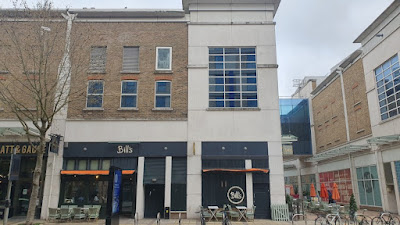 |
| April 2023 |
Hartfield Road proved a temporary home for Domark. They were there from early 1987 to autumn 1988. The Empire Strikes Back, released in July 1988, carries the Hartfield Road address. While Live and Let Die (all together now) The Computer Game, released October 1988, shows the company based at a new address in Putney. According to ACE, (September 1988 page 8) in a slightly baffling article which persists in calling Strachan and Wheatley "twits" (I'm sure it's all jolly good fun and done in an affectionate tone), Domark was moving to gain "needed extra space." The whole area has been subsequently cleared and redeveloped into a big gym/supermarket/dining area and you can now eat at 22 Hartfield Road because it's a branch of restaurant Bill's which seems to spread across number 20-22.
Ferry House, 51-57 Lacy Road, Putney, SW15
Domark stayed at Ferry House until their merger with Eidos in 1994. It's business as usual for the company. More Atari/Tenegen arcade conversions. More James Bond games, Licence to Kill in 1989, the point at which Domark finally stopped using the The Computer Game subtitle and The Spy Who Loved Me in 1990. The company moved over to support 16-bit machines and gradually dropped support for the C64, Spectrum, and Amstrad, by 1991 they appear to be only supporting the Atari ST, Amiga, and PC formats. Dominic Wheatley told MONEY WEEK: "One of our biggest challenges was to pick the right platform. There was no point making a game if no one bought the machine that played it." At various times they released games for the SEGA Game Gear, Atari Lynx, Super Nintendo, SEGA Megadrive, 3DO, Amstrad GX4000, and the other systems which mushroomed in the early to mid-nineties until the market stabilised around the Sony, Microsoft, and Nintendo consoles. The Championship Manager series began at Ferry House. Domark also released the official Spitting Image computer game, Splitting Images was presumably water under the bridge at this point.
Speaking of bridges. Ferry House is just round the corner from Putney Bridge, or rather was. You won't be surprised to hear it no longer exists. Domark, like System 3, has had most of it's offices demolished and redeveloped. A modern building called the Glasshouse now stands on the site.
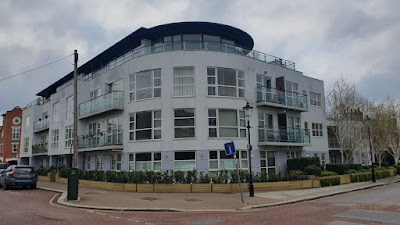 |
| April 2023 |
Domark's office in Lacy Road brought them almost full circle. Putney Bridge takes you across into Fulham and then Munster Road is just under a mile away.
Around 1992 Ian Livingstone joined the company as a director and Dominic Wheatley moved to America to open a US subsidiary. He described what happened next on a Reddit AMA: "I left for the US and left [Mark Strachan] to run the European team out of London. I'm not sure he really felt comfortable on his own. Couple of years later we agreed he'd move on and I replaced him with John Pirie. Later, we IPOed the company by reversing into a shell called Eidos (hence the name change from Domark) on the London Stock Exchange. Mark sold his shares and did alright."
The "reversing into a shell" manoeuvre was a way to take Domark public and float it on the stock exchange. Wikipedia tells me this reverse takeover is, "the acquisition of a public company by a private company so that the private company can bypass the lengthy and complex process of going public." Essentially Domark brought Eidos, then renamed itself and established Domark as a subsidiary of the new Eidos. I think. I studied geography at university. You know where you are with oxbow lakes.
The Kremlin: 24c The High Street, Addlestone, Surrey KT15 1TL.
The success of Trivial Pursuit allowed Domark to set up an internal programming team, which was called the Kremlin. At first this group was based in Lacy Road but by October 1991 they had moved down the A3 to Addlestone in Surry, according to THE ONE magazine. I didn't think there was much chance of tracking down this office but to my surprise I found an Addlestone address for Domark in a magazine called THE ACORN EDUCATION DIRECTORY. Was this the address of the mysterious Kremlin? Who knows. Anyway, one day in March I fired up the old auto and drove to have a look. 24C is the building on the left of the picture.
 |
| March 2023 |
the Samrat Indian restaurant, where all important business decisions are made." The Indian restaurant is still there, dead opposite where Ferry House used to be, but in 2016 it changed its name to the Kashmir. Obviously not including a picture would be a betrayal of everything this blog stands for, so here it is.
 |
| April 2023 |
Finally, in July 1990, ACE visited Domark for it's first reader's conference. The article included this disturbing picture.
The caption reads: "Anil Khedun complained that there weren't any girls at the conference - but boss Mark Strachan shows that he can turn a pretty ankle when he wants to. With him are partner Dominic Wheatley and Incentive's Ian Andrew -both of whom were there to speak to the team." The picture has been scanned at too low a resolution to clearly make out what is going on, which is probably for the best, because who is playing the damsel? What venue allowed this sordid scene to take place? My first thought was St Mary's Church, Putney, barely four minutes walk from Lacy Road but the architecture round the door is all wrong. The sinful venue actually turned out to be All Saints Church, Fulham, at the other end of Putney Bridge. This was also where Patrick Troughton gets spiked by a falling lightning conductor in The Omen.
 |
| April 2022 |
Annoyingly some selfish git, or pair of gits, was getting married when I passed by. A cream coloured taxi was parked right in front of the doors and stopped me from getting a good angle for comparison. Congratulations on your happy day.
Domark's story ends in 1994 and continues with Eidos. Have I learned why there was a Domark-shaped hole in my nostalgia? Sort of. Mark Strachan told Graeme Kidd in 1988: "It’s taken us four years to really get on the road." I think that's the core of the problem. Domark's first few games just weren't good. In the early days of the UK software industry (or perhaps it's more accurate to say -the early days of my nostalgia) some companies released games which were an essential day one purchase; Ultimate, Microsphere, Graftgold, Bullfrog, and even individual authors stood out like Steve Crow, Starquake, and Julian Gollop, Chaos, X-Com, and so on. By the time Domark started releasing good games there was so much software available that while I would buy an individual title like Split Personalities or APB I didn't associate it with the company. It was simply a good game, not a Domark game.
"I've learned that games publishing is an exercise in optimism. :)" Dominic Wheatley, Reddit.
Let's close with an album of daft Domark PR photos.
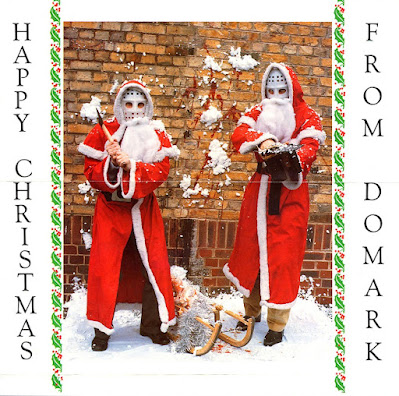 |
| Christmas greetings to promote Friday 13th Spectrum Computing website |
 |
| Dressed as hippies for the Trivial Pursuit Baby Boomer Edition game ZX COMPUTING May 1987 page 5 |
 |
| Blazers and boaters, and R2D2 and Jeffery Archer CRASH November 1987 page 12 |
 |
| Waving bottles of champagne to celebrate the Atari/Tenegen deal (plus hat) SINCLAIR USER 1989 page 39 |
 |
| Chasing Darth Vader across Wimbledon Common to promote Return of the Jedi YOUR SINCLAR September 1988 page 7 |
 |
| Looking fierce to promote Cyberball ACE March 1990 page 8 |
If you are Mark Strachan or Dominic Wheatley then please write in and let me know if you ever considered naming your company Mardom or Whestrach. Follow me on Twitter @ShamMountebank
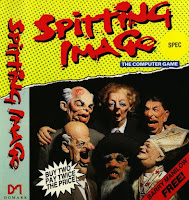
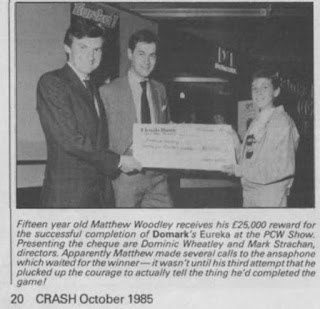


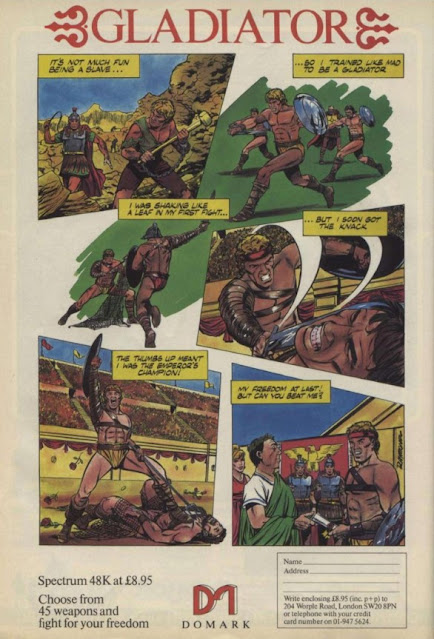
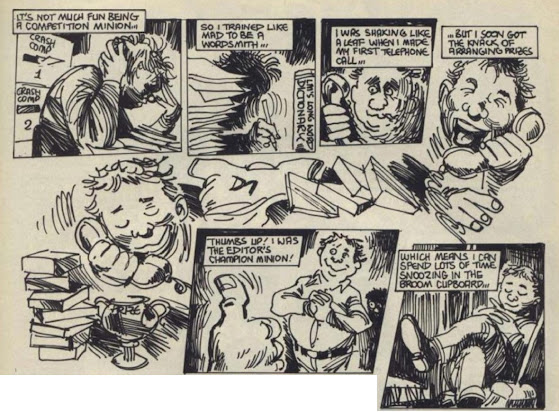
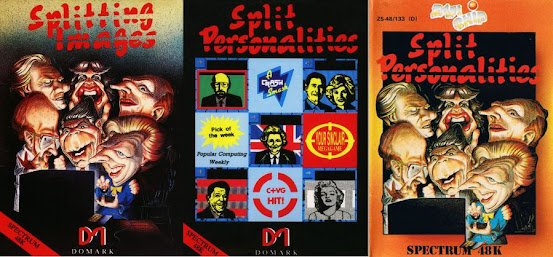









Really enjoying these articles after discovering your blog today. You could almost publish them as a book.
ReplyDelete